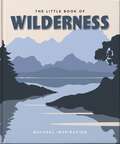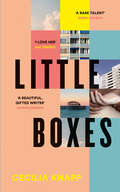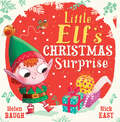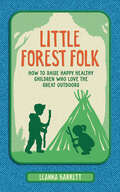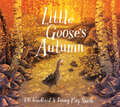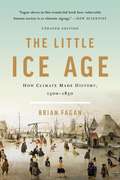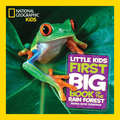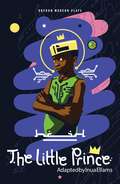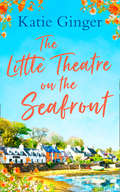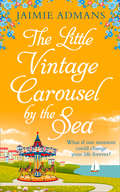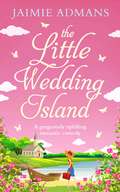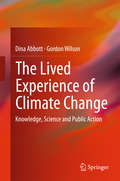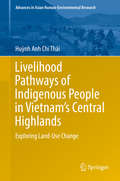- Table View
- List View
The Little Book of Weather (Little Books of Nature)
by Adam ScaifeA charming, richly illustrated, pocket-size exploration of the world&’s weatherPacked with surprising facts, this delightful and gorgeously designed book will beguile anyone who is curious about weather. Expertly written and beautifully illustrated throughout with color photographs and original color artwork, The Little Book of Weather is an accessible and enjoyable mini-reference about the world&’s weather, with examples drawn from across the globe. It fits an astonishing amount of information in a small package, covering a wide range of topics—from weather forecasting and extreme events such as hurricanes and typhoons to the future of weather with climate change. It also includes curious facts, myths, and history—from whether animals can predict the weather to the bad weather that helped doom Napoleon and Hitler&’s invasions of Russia and the Soviet Union. The result is an irresistible guide to the amazing world of weather.A beautifully designed pocket-size book with a foil-stamped cloth coverFeatures some 140 color illustrations and photosMakes a perfect gift
The Little Book of Whales (Little Books of Nature)
by Robert Young Annalisa BertaA charming, richly illustrated, pocket-size exploration of the world&’s whalesPacked with surprising facts, this delightful and gorgeously designed book will beguile any nature lover. Expertly written and beautifully illustrated throughout with color photographs and original color artwork, The Little Book of Whales is an accessible and enjoyable mini-reference about the world&’s whales, with examples drawn from across the globe. It fits an astonishing amount of information in a small package, covering a wide range of topics—from anatomy, diversity, and reproduction to habitat and conservation. It also includes curious facts and a section on whales in myths and folklore from around the world. The result is an irresistible guide to the amazing lives of whales.A beautifully designed pocket-size book with a foil-stamped cloth coverFeatures some 140 color illustrations and photosMakes a perfect gift
The Little Book of Whales (Little Books of Nature)
by Robert Young Annalisa BertaA charming, richly illustrated, pocket-size exploration of the world&’s whalesPacked with surprising facts, this delightful and gorgeously designed book will beguile any nature lover. Expertly written and beautifully illustrated throughout with color photographs and original color artwork, The Little Book of Whales is an accessible and enjoyable mini-reference about the world&’s whales, with examples drawn from across the globe. It fits an astonishing amount of information in a small package, covering a wide range of topics—from anatomy, diversity, and reproduction to habitat and conservation. It also includes curious facts and a section on whales in myths and folklore from around the world. The result is an irresistible guide to the amazing lives of whales.A beautifully designed pocket-size book with a foil-stamped cloth coverFeatures some 140 color illustrations and photosMakes a perfect gift
The Little Book of Wilderness: Wild Inspiration (The\little Book Of... Ser.)
by Orange Hippo!Discover wilderness as nature intended – the pristine places on our beautiful planet that still remain untouched by human hands. Explore the rugged mountains, clear waters and dense forests of the great outdoors, from the Himalayas to the Rockies, from icy fjord and to desert plateau and everything between.Including information on the best trails and trips to take around the globe, and inspirational quotes from explorers, conservationists and writers, this bitesize book will help wanderers of all walking speeds reconnect with the wonderful world outside their windows.SAMPLE FACT: Blaze: When wanderlusting in the wilderness, and lost, look to the trees to help you find a path. A blaze is a coloured marker, usually painted or nailed to a tree. It helps guide hikers when a trail becomes difficult to follow or makes an abrupt turn.
Little Boxes
by Cecilia Knapp‘Cecilia Knapp is a great writer. I love her’ KAE TEMPEST ‘Unmissable’ STYLIST
Little Elf's Christmas Surprise
by Helen BaughA festive picture book complete with calamity, chaos and one very loveable little elf!
The Little Encyclopedia of Enchanted Woodland Creatures: An A-to-Z Guide to Mythical Beings of the Forest (The Little Encyclopedias of Mythological Creatures)
by Jason LancasterRunning the gamut from A-to-Z and spanning the globe from the forest glens of Romania to the mountain aeries of Colorado, The Little Encyclopedia of Enchanted Woodland Creatures brings together all the most magical creatures of the forest. Naughty and nice, real and fictional, the menagerie of creatures included in this book encompass multiple world mythologies and cultures. This little encyclopedia features more than 90 famous woodland creatures from around the world, including: Andvari—a magical ring wearing dwarf from Norse Mythology who lives under a waterfall Baba Yaga—one of the most potent witches in all of folklore, said to live deep in the Russian forest Glawackus—a fearsome creature of the American woods that looks like a mix between a bear, a lion, and a panther Sasabonsam—creatures from Ghanaian folklore with red hair and iron teeth who are said to feast on those who wander past their forest home Also filled with descriptions of other powerful forest beings like dryads, fauns, elves, and gnomes, this information-packed guide includes gorgeous line drawings throughout.
The Little Encyclopedia of Mermaids: An A-to-Z Guide to Mystical Sea Creatures (The Little Encyclopedias of Mythological Creatures)
by Melissa MaxwellThe Little Encyclopedia of Mermaids is an A-to-Z compendium that spans the globe—from the Isle of Man to the depths of the Sea of Japan—weaving together famous and popular tales of everyone's favorite mythical sea creature. Naughty and nice, real and fictional, the menagerie of creatures included in this book run the gamut of world mythologies and cultures. This little encyclopedia features more than 90 famous mermaids including: Atargatis—a mermaid from ancient Syria who was a goddess before she fell in love with a mortal Blue Men of the Minch—a group of riddle-loving merfolk who have the power to summon storms and capsize ships Little Mermaid—everyone's favorite mermaid princess, who gives up her voice for a chance at love Ningyo—a gruesome sea creature from Japanese folkore that can bring dangerous storms and other misfortune Filled with tales of star-crossed mermaids and vengful sea gods and goddesses, this information-packed guide includes gorgeous line drawings throughout.
Little Forest Folk: How To Raise Happy, Healthy Children Who Love The Great Outdoors
by Leanna BarrettThis is a book with a mission. A mission to help parents get their little ones into loving and caring for the outside world. For the sake of their mental health, their physical health and – ultimately – the good of the planet too.
Little Gems – Nellie Choc-Ice and the Plastic Island (Little Gems)
by Jeremy StrongNellie Choc-Ice (the greatest penguin explorer in the world!) and Jeremy Strong return to fight the scourge of plastic in this funny and thoughtful gem.
Little Goose's Autumn
by Elli WoollardLittle Goose's Autumn is a second stunning story from an exciting picture book pairing and the uplifting tale of a lively young goose finding her place in the world.As summer fades to autumn, a lively young goose feels a change in the air and senses she has something important to do – but what? The beavers are chopping wood, the squirrels are storing nuts in the ground and the bears are busy building a den. The plucky little goose tries to join in, but without great success. She realizes her wings weren't built for chopping wood, or burying food, or building a den, but they were built for something magnificent – they were built for flight . . . A beautiful, lyrical and hopeful story about finding your wings and your place in the world. Written by star picture book author, Elli Woollard with wonderful illustrations by rising talent, Briony May Smith, whose artwork brings an autumnal landscape of mountains and forests to life with truly breathtaking beauty.
The Little Green Book of Eco-Fascism: The Plan to Frighten Your Kids, Drive Up Energy Costs and Hike Your Taxes!
by James DelingpoleDo you believe we should bomb our economy back to the dark ages? Carpet our beautiful countryside with bat-chomping, bird-slicing eco-crucifixes? Indoctrinate our kids with scary North Korea-style propaganda nonsense in order to deal with the alleged perils of 'climate change'? Neither does James Delingpole, author, polemicist, drowner of baby polar bears. From acid rain, food miles and the 'vanishing' Maldives to ocean acidification, fracking and the celebrity wankerati, Delingpole's characteristically witty, snarky, no-prisoners A to Z presents all that is wrong, funny and downright insane about the green movement - and gives you the ammunition you'll need to counter the great environmental myths of our brainwashed age.
The Little Ice Age: How Climate Made History 1300-1850
by Brian FaganOnly in the last decade have climatologists developed an accurate picture of yearly climate conditions in historical times. This development confirmed a long-standing suspicion: that the world endured a 500-year cold snap-The Little Ice Age-that lasted roughly from A.D. 1300 until 1850. The Little Ice Age tells the story of the turbulent, unpredictable and often very cold years of modern European history, how climate altered historical events, and what they mean in the context of today's global warming. With its basis in cutting-edge science, The Little Ice Age offers a new perspective on familiar events. Renowned archaeologist Brian Fagan shows how the increasing cold affected Norse exploration; how changing sea temperatures caused English and Basque fishermen to follow vast shoals of cod all the way to the New World; how a generations-long subsistence crisis in France contributed to social disintegration and ultimately revolution; and how English efforts to improve farm productivity in the face of a deteriorating climate helped pave the way for the Industrial Revolution and hence for global warming. This is a fascinating, original book for anyone interested in history, climate, or the new subject of how they interact.
Little Kids First Big Book of the Rain Forest (First Big Book)
by National Geographic Kids Moira Rose DonohueColoful birds! Jaguars! Tree frogs! National Geographic presents a delightful, age-appropriate introduction to tropical rain forest creatures big and small in this new title in the popular Little Kids First Big Book series.
A Little Less Arctic: Top Predators in the World's Largest Northern Inland Sea, Hudson Bay
by Steven H. Ferguson Lisa L. Loseto Mark L. MalloryIn Arctic Canada, Hudson Bay is a site of great exploration history, aboriginal culture, and a vast marine wilderness supporting large populations of marine mammals and birds. These include some of the most iconic Arctic animals like beluga, narwhal, bowhead whales, and polar bears. Due to the challenges of conducting field research in this region, some of the mysteries of where these animals move, and how they are able to survive in such seemingly inhospitable, ice-choked habitats are just now being unlocked. For example, are polar bears being replaced by killer whales? This new information could not be more salient, as the Hudson Bay Region is undergoing rapid environmental change due to global warming, as well as increased pressures from industrial development interests. A Little Less Arctic brings together some of the world’s leading Arctic scientists to present the current state of knowledge on the physical and biological characteristics of Hudson Bay.
Little Orangutan All Alone: Book 3 (Baby Animal Friends #3)
by Tilda KellyA young girl and an orphaned orangutan born find new mums in this heartwarming story about friendship and family.Erin's new foster mum, Rachel, seems nice - but Erin doesn't trust her. She's been hurt too many times before and knows better than to form attachments. But when Rachel takes her to the primate sanctuary where she works, animal-lover Erin feels an instant connection with a cheeky little chimp and an orphaned baby orangutan. Can Erin help Budi the baby orangutan bond with its surrogate mum?
The Little Prince (Oberon Modern Plays)
by Inua EllamsBroken down in the Sahara Desert, a pilot meets an extraordinary Little Prince, travelling across time and space to bring peace to his warring planet. Inua Ellams’ magical retelling of the much loved story by Antoine de Saint-Exupéry turns the Little Prince into a descendant of an African race in a parallel galaxy. His journey as a galactic emigrant takes us through solar systems of odd planets with strange beings, addresses climate change and morality, and shows how even a little thing can make a big difference.
The Little Theatre on the Seafront
by Katie Ginger*Shortlisted for the Katie Fforde Debut Romantic Novel Award 2019!* When Lottie’s Gran dies she leaves one last request; save Greenley Theatre.
The Little Vintage Carousel by the Sea
by Jaimie AdmansWhat if one moment could change your life forever? Ness has almost resigned herself to being single forever, when she catches sight of the most gorgeous man she’s ever seen on the train to work.
The Little Wedding Island
by Jaimie Admans‘Just fabulous!’ Sparkly Word ‘Will you… pretend to marry me?’
A Livable Planet: Human Rights in the Global Economy
by Madison PowersHumanity faces an ecological predicament, consisting of a cluster of concurrent, mutually reinforcing crises. They are causally intertwined and resistant to resolution in isolation. In addition to climate disruption, the cluster includes land-system change, loss of biodiversity and biosphere integrity, alteration of biogeochemical cycles, and decreased freshwater availability. Madison Powers argues for a targeted human rights approach to the resolution of our predicament. He assigns priority to a bundle of rights strategically important for counteracting ecologically unsustainable, economically predatory market practices. These practices exhaust natural resources or degrade the environmental conditions essential for a livable planet. Their harmful ecological effects result from or are exacerbated by the structure of the global political economy, especially institutions that influence the acquisition, control, and use of land, energy, and water resources. These institutions shape the economic decisions that have transformed every region of the globe and altered the planetary conditions that support life on Earth. A livable planet thus requires changes in humanity's relation to the rest of nature, which in turn, requires transformation of our economic relationships and the political and economic ideals underpinning them. Specifically, the balance of power between states and markets should be reversed by implementing an enforceable institutional bulwark against market practices that subvert the ecological conditions essential for the secure realization of human rights. These practices enable the powerful to hoard economic opportunities, crowd out sustainable alternatives, extract resources from vulnerable communities, shift environmental and economic burdens, dodge political and market accountability, and hijack public institutions for private purposes.
A Livable Planet: Human Rights in the Global Economy
by Madison PowersHumanity faces an ecological predicament, consisting of a cluster of concurrent, mutually reinforcing crises. They are causally intertwined and resistant to resolution in isolation. In addition to climate disruption, the cluster includes land-system change, loss of biodiversity and biosphere integrity, alteration of biogeochemical cycles, and decreased freshwater availability. Madison Powers argues for a targeted human rights approach to the resolution of our predicament. He assigns priority to a bundle of rights strategically important for counteracting ecologically unsustainable, economically predatory market practices. These practices exhaust natural resources or degrade the environmental conditions essential for a livable planet. Their harmful ecological effects result from or are exacerbated by the structure of the global political economy, especially institutions that influence the acquisition, control, and use of land, energy, and water resources. These institutions shape the economic decisions that have transformed every region of the globe and altered the planetary conditions that support life on Earth. A livable planet thus requires changes in humanity's relation to the rest of nature, which in turn, requires transformation of our economic relationships and the political and economic ideals underpinning them. Specifically, the balance of power between states and markets should be reversed by implementing an enforceable institutional bulwark against market practices that subvert the ecological conditions essential for the secure realization of human rights. These practices enable the powerful to hoard economic opportunities, crowd out sustainable alternatives, extract resources from vulnerable communities, shift environmental and economic burdens, dodge political and market accountability, and hijack public institutions for private purposes.
The Lived Experience of Climate Change: Knowledge, Science and Public Action
by Dina Abbott Gordon WilsonThis book explores the idea that daily lived experiences of climate change are a crucial missing link in our knowledge that contrasts with scientific understandings of this global problem. It argues that both kinds of knowledge are limiting: the sciences by their disciplines and lived experiences by the boundaries of everyday lives. Therefore each group needs to engage the other in order to enrich and expand understanding of climate change and what to do about it.Complemented by a rich collection of examples and case studies, this book proposes a novel way of generating and analysing knowledge about climate change and how it may be used. The reader is introduced to new insights where the book:• Provides a framework that explains the variety of simultaneous, co-existing and often contradictory perspectives on climate change.• Reclaims everyday experiential knowledge as crucial for meeting global challenges such as climate change.• Overcomes the science-citizen dichotomy and leads to new ways of examining public engagement with science. Scientists are also human beings with lived experiences that filter their scientific findings into knowledge and actions.• Develops a ‘public action theory of knowledge’ as a tool for exploring how decisions on climate policy and intervention are reached and enacted.While scientists (physical and social) seek to explain climate change and its impacts, millions of people throughout the world experience it personally in their daily lives. The experience might be bad, as during extreme weather, engender hostility when governments attempt mitigation, and sometimes it is benign. This book seeks to understand the complex, often contradictory knowledge dynamics that inform the climate change debate, and is written clearly for a broad audience including lecturers, students, practitioners and activists, indeed anyone who wishes to gain further insight into this far-reaching issue.
Livelihood Pathways of Indigenous People in Vietnam’s Central Highlands: Exploring Land-Use Change (Advances in Asian Human-Environmental Research)
by Huỳnh Anh TháiThis study focuses on impacts of the environmental and socio-economic transformation on the indigenous people's livelihoods in Vietnam's Central Highlands recent decades since the country's reunification in 1975.The first empirical section sheds light on multiple external conditions (policy reforms, population trends, and market forces) exposed onto local people. The role of human and social capital is examined again in a specific livelihood of community-based tourism to testify the resilience level of local people when coping with constraints. The study concludes with an outlook on implications of development processed which still places agriculture at the primary position livelihood, and pays attention to human capital and social capital of indigenous groups in these highlands.
Livelihoods, Natural Resources, and Post-Conflict Peacebuilding (Post-Conflict Peacebuilding and Natural Resource Management)
by Helen Young Lisa GoldmanSustaining and strengthening local livelihoods is one of the most fundamental challenges faced by post-conflict countries. By degrading the natural resources that are essential to livelihoods and by significantly hindering access to those resources, conflict can wreak havoc on the ability of war-torn populations to survive and recover. This book explores how natural resource management initiatives in more than twenty countries and territories have supported livelihoods and facilitated post-conflict peacebuilding. Case studies and analyses identify lessons and opportunities for the more effective design of interventions to support the livelihoods that depend on natural resources – from land to agriculture, forestry, fisheries, and protected areas. The book also explores larger questions about how to structure livelihoods assistance as part of a coherent, integrated approach to post-conflict redevelopment. Livelihoods and Natural Resources in Post-Conflict Peacebuilding is part of a global initiative to identify and analyze lessons in post-conflict peacebuilding and natural resource management. The project has generated six books of case studies and analyses, with contributions from practitioners, policy makers, and researchers. Other books in this series address high value resources, land, water, assessing and restoring natural resources, and governance.


